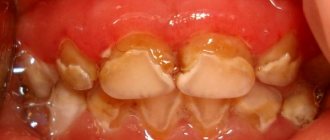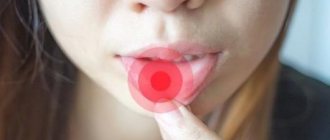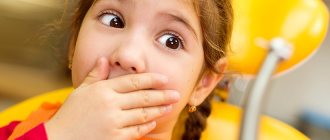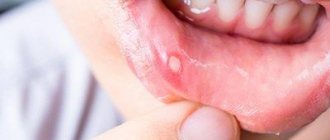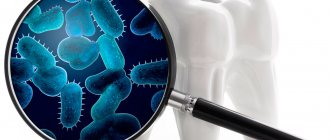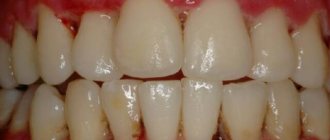Inflammatory gum disease in adults and children is called gingivitis. It is most often observed in children a few months from birth to 13 years of age, which is explained by the characteristics of the child’s body and poor oral hygiene.
According to statistics, in a child from 2 to 4 years old, gum inflammation occurs in 2% of cases, and by the age of 13, the proportion of this disease in children reaches 80%. Gingivitis cured in time does not become chronic, but if left untreated it can cause the development of periodontitis.
Causes of gingivitis in children
There are many causes for childhood gingivitis. The gums become inflamed due to the functional immaturity of their tissues. In babies under one year of age, the cause of the disease is often teething, when the gums become red and sore. Sometimes inflammation is caused by an allergic reaction to food.
In adolescents, the disease may manifest itself due to the eruption of a permanent tooth. When soreness during brushing does not allow this procedure to be performed efficiently, microbes multiply and gum inflammation develops.
The most common factors that provoke the development of gingivitis in older children are:
Action of microbes
In 90% of cases, the disease appears in a child due to insufficient oral hygiene, as a result of which microorganisms multiply intensively, plaque and tartar form, and stomatitis develops.
Mechanical injury
The integrity of the mucous cavity can be compromised by teething, cuts, scratches, burns, biting, improper brushing of teeth, and eating solid foods.
Foci of infection in the oral cavity
If children have carious teeth, there is a chance that they will develop infectious gingivitis, which affects the gums. Therefore, teeth that require treatment must be treated as soon as possible.
Excessive loads on the dental system
Other causes of gum damage in children may include:
- presence of malocclusion;
- poor nutrition with a lack of vegetables and fruits;
- uneven load on the dental system due to bad habits;
- defects of the oral cavity (short frenulum of the tongue, lips);
- the presence of caries, various infections;
- thermal burn from hot food;
- wearing braces.
Inflammation of the gums in a child with periodontitis -
If left untreated, dental caries gradually turns into pulpitis, and then into periodontitis. In moments of exacerbation, periodontitis occurs with the appearance of swelling of the gums, the formation of cysts, fistulas on the gums with purulent discharge.
In Fig. 9-10 you can see in the projection of the roots of the destroyed teeth (in both cases this is the central upper incisor) - there is a limited swelling on the gum, filled with pus. In both cases, the inflammation was caused by an infection in the area of the root apex of the central upper incisor.
Read more about gum inflammation in children with periodontitis in children - here
Symptoms
Gingivitis has a main symptom by which it is easily identified - inflammation affecting the child’s gums. The process begins with a slight redness that quickly gains strength. This signal often goes unnoticed by parents, and children go to the dentist with an active inflammatory process, bright red swollen gums, burning, and pain. These signs indicate that the disease has entered an acute phase.
Children suffer most from the catarrhal form of this disease, which can be chronic or acute. In the first case, the symptoms are not pronounced, pain occurs only when brushing, there is slight swelling, redness, and cyanosis of the gums.
A sign of an acute form of the disease is intoxication of the child’s body. It manifests itself as headache, nausea, lethargy, and fever.
The most complex type of disease, ulcerative gingivitis, manifests itself as follows:
- the inflammatory process progresses;
- their structure changes;
- there is an unpleasant odor from the mouth;
- lymph nodes in the neck enlarge;
- saliva is produced profusely;
- the skin turns pale.
If these signs are left unattended, an ulcerative-necrotic form of the disease may occur, when necrotic areas with a gray-green coating and a putrid odor appear on the gums, saliva becomes viscous, body temperature rises and the general condition significantly worsens.. All this indicates severe intoxication in organism.
During puberty in a teenager or if he has problems with hormones, hypertrophic gingivitis occurs. It occurs due to improper orthodontic treatment of dental anomalies. The inflammatory process is accompanied by increased growth of gingival tissue, which leads to partial closure of dental crowns. This form of the disease is usually localized. One or two gums are affected, sometimes the affected area expands. The most common location is the lower anterior incisors and canines.
Atrophic gingivitis does not have a pronounced inflammatory process and occurs without pain, although over time it can be complicated by periodontal disease.
Symptoms of gingivitis against the background of herpetic stomatitis -
Very often, with viral herpetic stomatitis, concomitant acute gingivitis occurs. In this case, the periodontal papillae and the marginal part of the gums increase due to swelling and become bright red. Read more about gum inflammation due to stomatitis in the article: “Treatment of various forms of stomatitis in children.” We hope that our article on the topic: Gingivitis in children treatment was useful to you!
Sources:
1. The author’s higher professional education in dentistry, 2. Personal experience as a periodontist, 3. The European Academy of Paediatric Dentistry (EU), 4. National Library of Medicine (USA), 5. “Pediatric therapeutic dentistry. National leadership" (Leontyev V.K.).
Diagnostic methods
The diagnosis is made by a doctor based on the results of studying the medical history and life of the child in combination with a dental examination. The patient’s complaints, the presence of somatic diseases, and whether he is taking medications that may cause the development of gingivitis are clarified.
Then the doctor conducts an external examination, paying attention to maxillofacial anomalies, the condition of the teeth and gums, and makes a diagnosis. The dentist does not require the help of other specialists, since the disease clearly manifests itself externally and does not require instrumental examination.
Folk remedies
Traditional methods are based on the specific properties of plants, decoctions of which have a good anti-inflammatory effect.
Sage.
Pour two tablespoons of the herb into 0.5 liters of boiling water, boil for 10-15 minutes, leave for an hour. Rinse your mouth 2-3 times a day. The decoction relieves inflammation well and reduces bleeding gums.
Pine needles.
Pour 1-2 tablespoons of needles into a glass of hot water, bring to a boil, leave for 40 minutes. Use 3-4 times a day. The infusion has a strong antimicrobial effect.
Aloe.
Chew peeled and well-washed leaves several times a day.
Pharmaceutical camomile.
Take chamomile flowers and linden flowers in equal proportions. Pour boiling water over tablespoons of the mixture, boil for 20 minutes, and let steep for half an hour. The infusion has a pronounced anti-inflammatory effect. Apply three times a day.
Herbal collection
(mix oregano, St. John's wort, peppermint in a ratio of 1:1:2). Pour three tablespoons of the mixture into 1.5 cups of boiling water and simmer for another 30 minutes. Leave for two hours, rinse three times a day. The decoction helps relieve inflammation and pain, eliminates bleeding and bad breath.
Treatment
Treatment for childhood gingivitis is practically no different from how adults are treated. Only medications used for them are softer and more gentle. Treatment begins with professional cleaning of hard deposits and plaque of tooth enamel - mechanical or ultrasonic.
If caries is detected during the examination, then therapeutic treatment is carried out. Gingivitis is then treated with medications with antiseptic and anti-inflammatory properties. Measures are taken to eliminate detected pathologies (bite, frenulum, etc. are corrected).
Ointments and gels are considered effective for children under 4 years of age. For example, Cholisal ointment has analgesic and anti-inflammatory properties, which makes it possible to prescribe it to alleviate the patient’s condition, especially when baby or permanent teeth are cutting. Ointments and gels are applied directly to the inflamed area.
Antibiotics in tablets or in the form of injections are prescribed to children in difficult cases (the presence of infections of bacterial origin in the body). At elevated temperatures, rinses, drinking plenty of fluids, antioxidants, antipyretic drugs for children, and taking vitamins are prescribed.
Prevention measures should include regular visits to the pediatric dentist, training in oral care rules, and parental monitoring of the development of hygiene skills.
Medicines for gingivitis
The medications your child needs are prescribed only by a doctor, based on the clinical picture of the disease and the individual condition of your child. Self-medication in this case is unacceptable, as it can lead to significant complications, including osteoporosis of bone tissue.
What to smear
Gels and ointments are applied after rinsing the mouth. The surfaces are pre-dried with a cotton swab or gauze.
Holisal.
The gel has a good anti-inflammatory and analgesic effect. Apply three times a day to the affected areas of the gums.
Apident active.
An ointment based on natural ingredients that quickly relieves pain and inflammation. The composition is applied to the inflamed areas and rubbed in with gentle circular movements.
Solcoseryl.
Used to heal bleeding areas, the gel is applied to both sides of the gums. Use as prescribed by a doctor.
Asepta gel.
Mainly prescribed for the treatment of chronic gingivitis. The drug relieves inflammation, pain, and itching well. Apply 2-3 times a day depending on the severity of the condition.
How to rinse
Important. Alcohol tinctures should not be used for rinsing, as their use will lead to even greater irritation.
Rinsing is mandatory when carrying out anti-inflammatory therapy. Carry out after each meal and additionally throughout the day. For young children, parents apply applications using cotton swabs soaked in solutions. In severe cases, treatment of the oral cavity and gums is carried out in the dental office.
For rinsing the following is prescribed:
- Chlorhexidine 0.05%.
Use after every meal. Rinse your mouth vigorously for 30 seconds. - Furacilin.
Use a ready-made 0.02% rinse aid or dissolve one tablet in a glass of boiled water. The drug disinfects the oral cavity well. - Furamistin 0.01%.
It has a powerful antibacterial effect and is used after meals. - Herbal infusions.
Prepare at home in accordance with doctor's recommendations.
Important. Before using solutions, rinse your mouth with clean water to remove any remaining food.
Antibiotics
In the chronic stage and in severe forms of the disease (ulcerative, ulcerative-necrotic), as well as in cases of high risk of complications, antibiotics are prescribed. The doctor selects the drug and dosage individually.
Types of inflammatory processes
Gingivitis
Inflammation of the gums at the initial stage, that is, not yet spreading to the bone tissue, is called gingivitis.
Treatment of gingivitis in children follows the same principle as in adults, with the only difference being that children are prescribed more gentle medications. When starting the procedure, the hygienist performs professional cleaning, removing plaque and stone, after which he teaches the little patient proper hygiene techniques. Helps you navigate the selection of toothpaste and brush.
Periodontitis
Inflammation of the gums and periodontal tissues - periodontitis - is an advanced stage of gum disease. If left untreated, its progression may result in one or more teeth having to be removed.
Treatment includes occupational hygiene and physical therapy. If the process is advanced, surgical intervention may be required.
Periodontal disease in children
The defeat of all periodontal tissues, in this case, is called childhood periodontal disease. This degree is quite rare. Progression can be triggered by weakened immunity and vitamin deficiency.
An effective option in this case is surgical intervention, as well as strengthening the general condition of the body.
Stomatitis in children
Infectious inflammation of the mucous membrane of the gums, or stomatitis, is characterized by increased sensitivity and discomfort while eating. Therefore, you should show it to a dentist as soon as possible. A dental clinic specialist will examine the baby and prescribe appropriate procedures.
Gum atrophy
A rather unique and rare disease - gum atrophy or exposing atrophic gingivitis manifests itself as itching in the area of 2, less often 4 and 6 symmetrically located milk teeth. A child experiencing discomfort constantly rubs the area of inflammation. At night, the itching usually intensifies.
The interdental papillae and other areas of the gums do not change in any way during gingival atrophy. Slight deposits of tartar are often observed on the unprotected root surface.
The manifestation of itching can be a consequence of measles or influenza, despite the fact that in most young patients such a relationship is not observed. The process of teething is also one of the factors causing itching in infants.
How to prevent gum disease
For the reasons listed above, we recommend that you:
- Closely monitor how thoroughly and correctly your child brushes his teeth;
- Use a special fingertip to massage the baby’s gums during teething;
- Explain to your child how important it is to actively chew food on both sides;
- Contribute to timely correction of bite and solution of other problems;
- Monitor the temperature of your baby's food and drink and ensure that he does not have the opportunity to injure the delicate gum tissue.
Modern pediatric dentistry believes that minimizing the unpleasant consequences of developing a serious disease by strengthening preventive measures is the easiest way to protect your child from diseases of the gums and other periodontal tissues.
Preventive actions
The best prevention of inflammation of the mucous membrane is daily and high-quality hygiene from an early age and proper nutrition.
Hygiene
The concept of “quality hygiene” includes brushing your teeth at least twice: in the morning and in the evening, in conjunction with cleaning the palate and tongue.
Parents should take a very responsible approach to hygiene from the day the first tooth appears. And after he grows up a little, learn the rules of brushing his teeth: regularly and efficiently. The toothbrush and toothpaste should be selected according to the age of the small patient.
Nutrition
In addition to hygiene, parents need to approach the diet wisely: it should be balanced and include vitamins and minerals. Sweets and carbonated drinks should be consumed by the child in limited quantities. In addition, after finishing eating sweets, the baby should rinse his mouth with water and, if possible, brush his teeth. Note that a diet that promotes the proper development of a growing body includes nutritious and timely meals. Snacking and disordered eating should be kept to a minimum.
How to treat gingivitis in childhood
A periodontist treats gum disease. At the appointment, the dentist conducts a survey of parents: what complaints does their baby have, when did they appear, and so on. After this, the periodontist examines the oral cavity.
How to treat gum gingivitis: first of all, you need to eliminate the cause of the disease, that is, remove plaque and stones. For this purpose, professional hygiene is carried out. The doctor carefully and painlessly removes dental deposits from the surface of the enamel using various devices. After this, the specialist gives recommendations for care, teaches the child and his parents how to brush their teeth correctly.
Do not self-medicate, consult a doctor!
Don't wait for your condition to worsen!
Sign up
How to treat gingivitis in a child is a question often asked by parents at an appointment with a pediatric dentist. No home or pharmacy remedy will help eliminate the cause of the disease. Only a visit to a periodontist and professional hygiene will help cure this pathology. The same answer will be to the question: “How to treat gingivitis in a 7-year-old child”?

